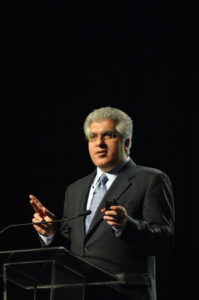
“Irksome Geopolitical Concerns” Are Potential Curveballs to 2020 Economic Growth Prospects
 ATLANTA–Having the Federal Reserve on hold for the foreseeable future, bipartisan agreement on fiscal spending and the signed phase one tariff deal with China have reduced the uncertainty that typically bedevil growth prospects, according to Rajeev Dhawan of the Economic Forecasting Center at Georgia State University’s Robinson College of Business.
ATLANTA–Having the Federal Reserve on hold for the foreseeable future, bipartisan agreement on fiscal spending and the signed phase one tariff deal with China have reduced the uncertainty that typically bedevil growth prospects, according to Rajeev Dhawan of the Economic Forecasting Center at Georgia State University’s Robinson College of Business.
“The seeds for 2020 growth were sown last year,” Dhawan wrote in his “Forecast of the Nation,” released Feb. 26, 2020. “In early 2019, business investment was already waning (after the boost from the Dec. 2017 tax reforms) when it hit a few potholes.”
Those potholes were the shocks of a sharp drop in oil prices and the grounding of Boeing’s 737 MAX, causing a contraction in business spending by late 2019.
“The die was cast for a growth slowdown in 2020,” Dhawan said.
The typical economic pullback experienced during a presidential election year began earlier than usual this cycle when election rhetoric heated up ahead of when expected.
Dhawan posits that subpar GDP growth (1.6 percent) in the first half of 2020 will be followed by a ramped-up GDP of 2.0 percent in the year’s second half due to a “positive exigent circumstance” when the 737 MAX returns to the skies in mid-to-late summer – tempering the impact of the ongoing presidential cycle slowdown.
Potential curveballs could beset Dhawan’s baseline forecast, the most obvious being a delayed return of the 737 MAX.
The forecaster is more concerned about what he described as “irksome geopolitical concerns” – e.g., Middle East flare-ups affecting oil production and capacity, kinks in the trade deal with China, post-Brexit uncertainty in EU-UK relations, action on past threats about German auto exports, and COVID-19, the coronavirus that first appeared in late 2019 in Hubei province, China, which Dhawan said is “the biggest threat to the 2020 forecast.
“At present, the key issue for us the incidence of spread of the virus outside China, and the Chinese have taken steps to limit it,” Dhawan said. “But, unlike a finite event, such as a hurricane or earthquake, the coronavirus is still playing out, making it hard to assess economic impact.”
The biggest economic problem now, according to Dhawan, is that factory workers are stuck at home after the Chinese New Year holiday.
“China is a vital part of the world’s supply chain for goods ranging from toys to iPhones. For an economic impact to happen, this disruption would need to last awhile, say until mid-April. When inventories run out, what will Amazon sell here? What will Apple and Samsung do?” Dhawan asked. “This is what I worry about the most.”
Highlights from the Economic Forecasting Center’s National Report
- Overall GDP growth will be 1.8 percent in 2020, 2.0 percent in 2021 and 1.7 percent in 2022.
- Investment growth will be only 0.6 percent in 2020, 4.3 percent in 2021 and 3.6 percent in 2022. Monthly job gains will be 143,000 in 2020, drop to 104,200 in 2021 and a similar 94,400 in 2022.
- Housing starts will average 1.258 million in 2020, 1.224 million in 2021 and 1.234 million in 2022. Vehicle sales will average 16.3 million in 2020, and 16.0 million in 2021 and 2022.
- The 10-year bond rate will average 1.9 percent in 2020, 2.7 percent in 2021 and 3.0 percent in 2022.
